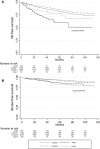Epidemiology and Natural History of the Cardiorenal Syndromes in a Cohort with Echocardiography
- PMID: 28801528
- PMCID: PMC5628717
- DOI: 10.2215/CJN.04020417
Epidemiology and Natural History of the Cardiorenal Syndromes in a Cohort with Echocardiography
Abstract
Background and objectives: It is unknown whether echocardiographic parameters are independently associated with the cardiorenal syndrome. No direct comparison of the natural history of various cardiorenal syndrome types has been conducted.
Design, setting, participants, & measurements: Our retrospective cohort study enrolled adult patients with at least one transthoracic echocardiography between 2004 and 2014 at a single health care system. Information on comorbidities was extracted using condition-specific diagnostic codes. All-cause mortality was the primary outcome among patients with cardiorenal syndrome types 1-4. Myocardial infarction and stroke were the secondary outcomes.
Results: In total, 30,681 patients were included, and 2512 (8%) developed at least one of the cardiorenal syndromes: 1707 patients developed an acute form of the syndrome (type 1 or 3), 128 patients developed type 2, and 677 patients developed type 4. In addition, 16% of patients with type 2 and 20% of patients with type 4 also developed an acute cardiorenal syndrome, whereas 14% of patients with acute cardiorenal progressed to CKD or chronic heart failure. Decreasing left ventricular ejection fraction, increasing pulmonary artery pressure, and higher right ventricular diameter were independently associated with higher incidence of a cardiorenal syndrome. Acute cardiorenal syndrome was associated with the highest risk of death compared with patients with CKD without cardiorenal syndrome (hazard ratio, 3.13; 95% confidence interval, 2.72 to 3.61; P<0.001). Patients with cardiorenal type 4 had better survival than patients with acute cardiorenal syndrome (hazard ratio, 0.48; 95% confidence interval, 0.37 to 0.61; P<0.001). Patients with acute cardiorenal syndrome and type 4 had increased risk of myocardial infarction and stroke compared with patients with CKD without cardiorenal syndrome.
Conclusions: Up to 19% of patients with a chronic form of cardiorenal syndrome will subsequently develop an acute syndrome. Development of acute or type 4 cardiorenal syndrome is independently associated with mortality, the acute form having the worst prognosis.
Keywords: Cardio-Renal Syndrome; Comorbidity; Confidence Intervals; Epidemiology and outcomes; Humans; Incidence; Prognosis; Pulmonary Artery; Renal Insufficiency, Chronic; Retrospective Studies; Stroke; Stroke Volume; echocardiography; heart failure; mortality; myocardial infarction.
Copyright © 2017 by the American Society of Nephrology.
Figures




References
-
- Bagshaw SM, Cruz DN, Aspromonte N, Daliento L, Ronco F, Sheinfeld G, Anker SD, Anand I, Bellomo R, Berl T, Bobek I, Davenport A, Haapio M, Hillege H, House A, Katz N, Maisel A, Mankad S, McCullough P, Mebazaa A, Palazzuoli A, Ponikowski P, Shaw A, Soni S, Vescovo G, Zamperetti N, Zanco P, Ronco C; Acute Dialysis Quality Initiative Consensus Group : Epidemiology of cardio-renal syndromes: Workgroup statements from the 7th ADQI consensus conference. Nephrol Dial Transplant 25: 1406–1416, 2010 - PubMed
-
- Ronco C, Haapio M, House AA, Anavekar N, Bellomo R: Cardiorenal syndrome. J Am Coll Cardiol 52: 1527–1539, 2008 - PubMed
-
- Ronco C, McCullough P, Anker SD, Anand I, Aspromonte N, Bagshaw SM, Bellomo R, Berl T, Bobek I, Cruz DN, Daliento L, Davenport A, Haapio M, Hillege H, House AA, Katz N, Maisel A, Mankad S, Zanco P, Mebazaa A, Palazzuoli A, Ronco F, Shaw A, Sheinfeld G, Soni S, Vescovo G, Zamperetti N, Ponikowski P; Acute Dialysis Quality Initiative (ADQI) consensus group : Cardio-renal syndromes: Report from the consensus conference of the acute dialysis quality initiative. Eur Heart J 31: 703–711, 2010 - PMC - PubMed
-
- McCullough PA, Kellum JA, Haase M, Müller C, Damman K, Murray PT, Cruz D, House AA, Schmidt-Ott KM, Vescovo G, Bagshaw SM, Hoste EA, Briguori C, Braam B, Chawla LS, Costanzo MR, Tumlin JA, Herzog CA, Mehta RL, Rabb H, Shaw AD, Singbartl K, Ronco C: Pathophysiology of the cardiorenal syndromes: Executive summary from the eleventh consensus conference of the Acute Dialysis Quality Initiative (ADQI). Contrib Nephrol 182: 82–98, 2013 - PubMed
-
- Haase M, Müller C, Damman K, Murray PT, Kellum JA, Ronco C, McCullough PA: Pathogenesis of cardiorenal syndrome type 1 in acute decompensated heart failure: Workgroup statements from the eleventh consensus conference of the Acute Dialysis Quality Initiative (ADQI). Contrib Nephrol 182: 99–116, 2013 - PubMed
Publication types
MeSH terms
Grants and funding
LinkOut - more resources
Full Text Sources
Other Literature Sources

